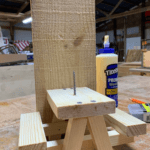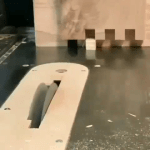Properly removing tape from woodwork after painting is a crucial step in achieving flawless results. It ensures clean lines, prevents damage, and allows the paint to fully cure without any interference. Many may overlook this step or rush through it, but taking the time to remove the tape correctly can make a significant difference in the final outcome of your painting project.
In this article, we will delve into the various aspects of removing tape from woodwork after painting. We will discuss factors to consider when understanding the drying time of different paints, as well as tools and techniques for preparing the woodwork before applying tape. We will also provide tips for determining how long to wait after painting before removing the tape for optimal results.
By properly timing and executing the removal of tape from woodwork, you can ensure that your painted surfaces have clean lines and avoid any unwanted damage or smudging. Additionally, we will explore common mistakes to avoid when removing tape and provide tips for achieving clean lines and preventing any damage during this process.
Furthermore, we will explore alternative methods to tape for protecting woodwork during painting, revealing other options that may offer better results depending on your specific project requirements. Whether you are a seasoned painter or a DIY enthusiast tackling a home improvement project, understanding when and how to remove tape from woodwork after painting is essential for flawlessly finished surfaces. Stay tuned for our step-by-step guide on properly removing tape and achieve professional-looking results every time.
Understanding the Drying Time of Different Paints
One of the key factors in knowing when to remove tape from woodwork after painting is understanding the drying time of different paints. The drying time can vary depending on several factors, and it is important to consider these factors to ensure optimal results.
The first factor to consider is the type of paint being used. Different types of paint have different drying times. Oil-based paints tend to have a longer drying time compared to water-based paints. It is essential to refer to the manufacturer’s instructions or consult with a professional in order to determine the specific drying time for the paint being used.
Another important factor to consider is the environmental conditions in which the painting project takes place. Humidity and temperature can greatly affect the drying time of paint. Higher levels of humidity can prolong the drying process, while hot temperatures can speed it up. It is advisable to paint in well-ventilated areas with moderate temperature and humidity levels for optimal drying times.
Additionally, application technique plays a role in determining how quickly paint dries. If paint is applied too thickly, it will take longer to dry. Thin and even coats allow for faster drying times. It is crucial to apply paint evenly and follow recommended application techniques provided by the manufacturer.
Understanding these factors will help determine when it is appropriate to remove tape from woodwork after painting. Removing tape too soon can result in smudging or smearing of freshly painted surfaces, while removing tape too late may cause it to adhere more firmly and potentially damage the painted surface. By considering the type of paint, environmental conditions, and application technique, one can make an informed decision on when it is best to remove tape for flawless woodwork results.
Preparing Woodwork Before Applying Tape
Before you start painting, it is important to properly prepare the woodwork to ensure clean lines and prevent any damage. Preparing the surface involves cleaning, sanding, and priming the woodwork before applying tape. Here are some tools and techniques that will help you achieve optimal results:
- Cleaning the woodwork: Use a mild detergent and water to clean the surface of the woodwork. This will remove any dust, dirt, or grease that may affect the adhesion of the tape.
- Sanding: Prior to taping, it is important to ensure a smooth surface by sanding the woodwork. Start with a coarse-grit sandpaper to remove any rough spots or imperfections, then switch to a finer grit for a smoother finish. Be sure to wipe away all dust after sanding before proceeding.
- Prime the woodwork: Applying a primer before taping will help with paint adhesion and prevent bleed-through of old stains or colors. Select a primer specifically designed for wooden surfaces and follow the manufacturer’s instructions for application.
Once you have prepared the woodwork, it is ready for tape application. Here are some techniques for best results:
- Choosing the right tape: Select painter’s tape specifically designed for delicate surfaces such as woodwork. Look for tapes that are easy to apply and remove without leaving residue or damaging paint.
- Applying tape with precision: Take your time when applying tape along edges or intricate details of the woodwork. Make sure it adheres firmly without stretching or tearing.
- Press down firmly: After applying the tape, use a putty knife or credit card to press down firmly along its entire length. This will ensure good adhesion and prevent paint from bleeding underneath.
By properly preparing your woodwork before applying tape and using these tools and techniques, you can effectively protect the wood and achieve clean lines during your painting project.
How Long to Wait After Painting Before Removing Tape
Removing tape from woodwork after painting requires careful consideration of the drying time of the paint used. The waiting period can vary depending on several factors, such as the type of paint and environmental conditions. It is important to wait for the right amount of time to ensure optimal results and prevent any damage to the painted surface.
One factor to consider when determining how long to wait before removing tape is the drying time of different paint types. Latex paints typically dry faster than oil-based paints, with most latex paints being touch-dry within an hour or two.
However, it is important to note that even though a paint may feel dry to the touch, it may not have fully cured yet. Oil-based paints, on the other hand, generally take longer to dry and cure, often requiring at least 24 hours or more before removing tape.
Environmental conditions can also affect drying times. Factors such as temperature and humidity levels can either accelerate or delay the drying process. Higher temperatures and lower humidity levels tend to promote faster drying, while colder temperatures and higher humidity levels can slow down drying times.
To determine if the paint is dry enough to remove tape, there are certain signs to look for. One indicator is if the paint has developed a hard surface finish that does not feel tacky or sticky when touched gently with a finger. Additionally, if you press a piece of masking tape onto the painted surface and it does not pull any paint off when removed, then it is likely safe to proceed with removing the tape from woodwork.
When it comes time to remove the tape from woodwork after painting, taking proper steps will help achieve clean lines without causing any damage. Begin by carefully peeling back the tape at a 45-degree angle while ensuring that you do not pull too forcefully or quickly. If you encounter resistance while peeling back the tape, it indicates that the paint may not be completely dry yet and needs more time.
| Type of Paint | Typical Drying Time |
|---|---|
| Latex Paint | Within an hour or two |
| Oil-based Paint | At least 24 hours or more |
Signs to Look for to Determine if the Paint is Dry Enough to Remove Tape
Understanding the Different Types of Paint
Before determining if the paint is dry enough to remove tape, it is important to understand the different drying times of various types of paint. The drying time can vary depending on factors such as the type of paint used, humidity levels, and ventilation in the room.
Water-based paints, such as latex or acrylic paints, generally have a faster drying time compared to oil-based paints. Latex paints typically dry within a few hours, while oil-based paints may take up to 24 hours or more to completely dry. It is crucial to consider these differences when deciding when to remove tape from woodwork after painting.
Checking for Surface Dryness
One of the key indicators that paint is dry enough to remove tape is surface dryness. To check if the paint has dried sufficiently for tape removal, gently touch a small inconspicuous area of the painted surface with your fingertip. If no paint residue comes off on your finger and the surface feels firm and dry to touch, it is likely that the paint has dried enough for tape removal.
Another way to determine surface dryness is by observing the appearance of the painted surface. If there are no visible marks or smudges left by touching or pressing lightly with a fingernail, this indicates that the paint has fully dried and it should be safe to remove the tape.
Considering Ambient Factors
While checking for surface dryness is an important step, it is also essential to consider ambient factors that could affect drying time. Higher levels of humidity and lack of proper ventilation can prolong drying times significantly. In such conditions, it may be necessary to wait longer than usual before removing tape from woodwork.
Additionally, cooler temperatures can also slow down the drying process. If you have painted in a cool environment or during colder months, it might be wise to give the paint some extra time to dry before removing the tape.
By paying attention to these signs and considering ambient factors, you can ensure that the paint on your woodwork is dry enough for tape removal without any risk of smudging or causing damage to the freshly painted surface.
Step-by-Step Guide
Gather Materials and Prepare the Work Area
Before starting the process of removing tape from woodwork after painting, it is important to gather all the necessary materials. You will need a utility knife or a sharp razor blade, a putty knife or a scraper, and possibly some rubbing alcohol or adhesive remover. Additionally, ensure that you have a clean workspace with good lighting to make the process easier.
Cut Along the Edges
To begin, carefully cut along the edges of the tape using a utility knife or a sharp razor blade. This will help to prevent any paint from peeling off when removing the tape. Make sure to use light pressure and follow along the edge of the tape, being mindful not to cut into the woodwork.
Pull Back at an Angle
Once you have cut along all edges of the tape, it is time to start removing it. Start by pulling back one corner of the tape at a 45-degree angle, slowly and steadily. Pulling at this angle helps to prevent any paint from lifting off with the tape and ensures clean lines on your woodwork.
Remove Any Residue
After removing all the tape, you may notice some adhesive residue left behind on your woodwork. To remove this residue, dampen a cloth with rubbing alcohol or use an adhesive remover specifically designed for paint. Gently rub the affected area until all residue is gone. Be cautious not to apply too much pressure as it may damage your freshly painted surface.
Inspect for Flaws
Carefully inspect your woodwork for any flaws or imperfections that may have occurred during the tape removal process. If you find any areas where paint has peeled off or uneven lines have formed, touch them up using a small brush and matching paint color. Take your time during this step to ensure a seamless finish.
Clean up and Enjoy
Once you have completed all the steps, clean up the work area by disposing of any used materials and wiping down any surfaces that may have collected dust or debris. Take a step back and admire your flawlessly painted woodwork. With the proper technique and timing, removing tape from woodwork after painting can result in clean lines and professional-looking results.
Common Mistakes to Avoid When Removing Tape from Woodwork
When removing tape from woodwork after painting, it is important to be aware of common mistakes that can lead to damage or an undesirable finish. By avoiding these pitfalls, you can achieve clean lines and protect the woodwork from any potential harm.
Firstly, one common mistake to avoid is leaving the tape on for too long. While it is important to wait for the paint to dry before removing the tape, leaving it on for an extended period of time can make it more difficult to remove and increase the risk of peeling off the paint along with the tape. It is recommended to remove the tape within 24-48 hours after painting, depending on the type of paint used.
Another mistake to avoid is pulling off the tape too quickly. Rapidly ripping off the tape can cause it to tear and leave behind a jagged edge or adhesive residue. Instead, take your time and gently peel back the tape at a 45-degree angle. This will help ensure a smooth removal without damaging the woodwork or disrupting the freshly painted surface.
Additionally, using improper tools when removing tape can also result in mistakes. Avoid using sharp objects such as knives or scrapers as they can easily gouge or scratch the woodwork. Instead, opt for a plastic scraper or your fingernail to carefully lift up and remove the tape. If there are any stubborn areas where the tape won’t come off easily, try heating it up with a hairdryer for a few seconds to soften the adhesive.
| Common Mistake | Tips for Avoiding |
|---|---|
| Leaving tape on for too long | Remove within 24-48 hours after painting |
| Pulling off tape too quickly | Gently peel back at a 45-degree angle |
| Using sharp objects to remove tape | Use plastic scraper or fingernail |
By being aware of these common mistakes and following the recommended tips, you can ensure a smooth and successful removal of tape from woodwork after painting. With proper technique and care, you will be able to achieve flawless results with clean lines and minimal damage to your woodwork.
Tips for Achieving Clean Lines and Preventing Damage When Removing Tape
Achieving clean lines and preventing damage when removing tape from woodwork is crucial for achieving a professional and flawless finish to your painting project. Here are some tips to help you achieve this:
- Use the right type of tape: When choosing tape for your painting project, it is important to use painter’s tape specifically designed for delicate surfaces such as woodwork. This type of tape is usually low-tack, which means it will adhere well enough to create sharp edges but can be easily removed without causing damage.
- Remove the tape at the right angle: To prevent any paint from peeling or chipping off with the tape, it is important to remove it at a 45-degree angle. This helps to ensure a clean break in the paint line and minimizes the risk of any damage.
- Remove the tape slowly and carefully: Take your time when removing the tape from woodwork after painting. Pulling it off too quickly may lead to paint bleed or even pulling off fresh paint along with it. Start by gently lifting one corner of the tape and gradually pull it back while keeping an eye on the painted edge.
- Use a utility knife or razor blade for stubborn areas: If you encounter any stubborn areas where the tape does not easily come off, do not force it as this may cause damage. Instead, use a utility knife or razor blade to carefully score along the edge of the taped area before attempting to remove it again.
- Clean up any residue immediately: After removing the tape, inspect the woodwork for any residue that might have been left behind. Any adhesive residue can be cleaned up using a mild solvent or rubbing alcohol on a clean cloth.
By following these tips, you can achieve clean lines and prevent damage when removing tape from woodwork after painting. Remember, patience and attention to detail are key in ensuring a flawless finish to your project.
Alternative Methods to Tape
While tape is a popular choice for protecting woodwork during painting, there are alternative methods that can also yield excellent results. These alternatives may offer added benefits such as preventing paint bleeding and reducing the risk of damage to delicate surfaces. Here are some options to consider when looking for alternative methods to tape.
One effective alternative method is using liquid masking solutions. Liquid mask is a rubbery compound that can be applied with a brush or roller onto the woodwork. It creates a protective barrier that can easily be peeled off once the paint is dry, leaving clean lines and preventing any damage or residue. Liquid mask is particularly useful for intricate details or irregular surfaces where traditional tape may not adhere properly.
Another option to consider is using plastic sheeting or drop cloths to cover the woodwork. This method works well when painting larger areas or entire rooms. By fully covering the woodwork, you eliminate the need for precise taping and reduce the risk of accidentally peeling off fresh paint when removing tape. Plastic sheeting and drop cloths can easily be secured with painter’s tape at the edges or corners, providing a reliable barrier against paint splatters.
Additionally, there are specialty products on the market specifically designed for protecting surfaces during painting. These include reusable adhesive film, which adheres directly to the surface without leaving any residue, and protective coatings that can be sprayed or brushed on. These alternatives offer convenience and ease of use, as they can be quickly applied and removed without any extra steps.
It’s important to note that while these alternative methods may offer advantages, it’s still crucial to prepare the woodwork properly before applying any protection. Ensure that surfaces are clean, dry, and free from any dust or debris that could affect adhesion or cause imperfections in the paint job.
By exploring these alternative methods for protecting woodwork during painting, you can find the one that best suits your needs and achieve flawless results without relying solely on tape.
Conclusion
In conclusion, removing tape from woodwork after painting is a critical step that should not be overlooked. The proper timing of tape removal is essential in achieving flawless and professional-looking results. By understanding the drying time of different paints and following the recommended waiting period, you can ensure that the paint is dry enough to remove the tape without causing any damage or ruining the final finish.
It is important to pay attention to signs that indicate whether the paint is dry enough for tape removal. These signs include touch-dryness, lack of tackiness, and no transferring of paint onto the tape when gently lifted. Waiting for these indicators will help prevent smudging or peeling off freshly applied paint.
When it comes to removing the tape, following a step-by-step guide is highly recommended. This includes using sharp tools such as a utility knife or painter’s tool to loosen the edges of the tape before peeling it off slowly and carefully at a 45-degree angle. Taking your time during this process will minimize any potential damage to the woodwork or paint.
Lastly, exploring alternative methods to tape can also be beneficial in protecting woodwork during painting. Options such as painter’s pyramids or liquid masking products provide an alternative approach that may yield better results in specific situations.
Frequently Asked Questions
How long can you leave painters tape on a painted surface?
Painters tape is typically designed to be left on a painted surface for a relatively short period of time. The exact duration can vary depending on factors such as the type of tape used, the quality of the paint, and the conditions in which it was applied. However, as a general guideline, it is advisable to remove the painters tape within 24 to 48 hours after painting.
Leaving it on for longer periods may lead to difficulties in removing the tape without damaging the paint or leaving behind residue. It is always recommended to check the specific instructions provided by the manufacturer of the painters tape being used.
Should I remove the masking tape immediately after painting the baseboard or should I wait for the baseboard to drive first?
It is generally recommended to remove masking tape immediately after painting the baseboard rather than waiting for it to dry. This is because when paint dries, it can create a strong bond between the surface and the tape, making it more difficult to remove without causing damage or peeling off some of the newly painted surface.
By removing the masking tape while the paint is still wet, you have a better chance of achieving clean lines and avoiding any unwanted smudging or tearing.
Do you take frog tape off when paint is wet or dry?
Frog Tape is designed specifically for use with wet paint and can be removed either when the paint is wet or dry. The choice of whether to remove it while wet or dry depends on personal preference and specific circumstances.
Some people find it easier to remove Frog Tape while the paint is still wet since it can help ensure sharper edges and prevent any dried paint from adhering to the edge of the tape during removal. On the other hand, others prefer to wait until the paint has fully dried before removing Frog Tape as this may reduce any risk of smearing or bleeding if there are touch-ups needed after removing small sections of tape.

Hi everyone! I’m a woodworker and blogger, and this is my woodworking blog. In my blog, I share tips and tricks for woodworkers of all skill levels, as well as project ideas that you can try yourself.





